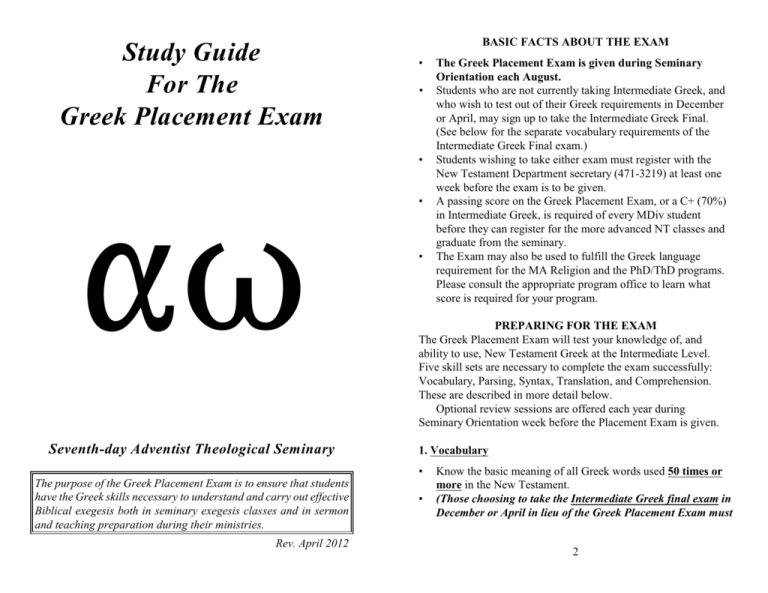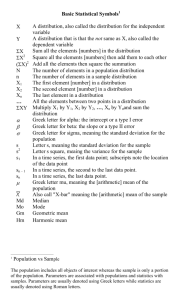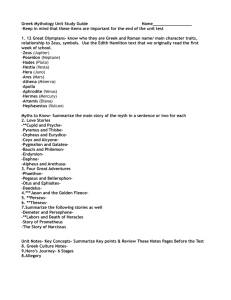Study Guide For The Greek Placement Exam
advertisement

Study Guide For The Greek Placement Exam BASIC FACTS ABOUT THE EXAM • • • "T Seventh-day Adventist Theological Seminary • • PREPARING FOR THE EXAM The Greek Placement Exam will test your knowledge of, and ability to use, New Testament Greek at the Intermediate Level. Five skill sets are necessary to complete the exam successfully: Vocabulary, Parsing, Syntax, Translation, and Comprehension. These are described in more detail below. Optional review sessions are offered each year during Seminary Orientation week before the Placement Exam is given. 1. Vocabulary • The purpose of the Greek Placement Exam is to ensure that students have the Greek skills necessary to understand and carry out effective Biblical exegesis both in seminary exegesis classes and in sermon and teaching preparation during their ministries. Rev. April 2012 The Greek Placement Exam is given during Seminary Orientation each August. Students who are not currently taking Intermediate Greek, and who wish to test out of their Greek requirements in December or April, may sign up to take the Intermediate Greek Final. (See below for the separate vocabulary requirements of the Intermediate Greek Final exam.) Students wishing to take either exam must register with the New Testament Department secretary (471-3219) at least one week before the exam is to be given. A passing score on the Greek Placement Exam, or a C+ (70%) in Intermediate Greek, is required of every MDiv student before they can register for the more advanced NT classes and graduate from the seminary. The Exam may also be used to fulfill the Greek language requirement for the MA Religion and the PhD/ThD programs. Please consult the appropriate program office to learn what score is required for your program. • Know the basic meaning of all Greek words used 50 times or more in the New Testament. (Those choosing to take the Intermediate Greek final exam in December or April in lieu of the Greek Placement Exam must 2 • • know all words used 30 times or more.) Don’t forget to pay attention to: • changes in the meaning of a preposition when followed by a genitive, dative, or accusative. • rough breathing marks Appropriate word lists may be found in: • Metzger, Bruce. Lexical Aids for Students of New Testament Greek. • Van Voorst, Robert. Building Your New Testament Greek Vocabulary. • Trenchard, Warren C. Complete Vocabulary Guide to the Greek New Testament. • Kubo, Sakae. A Reader’s Greek-English Lexicon of the New Testament (Appendix I). 2. Morphology : Parsing Individual Words • Be able to parse nouns, articles, adjectives, pronouns, and verbs. • Nouns (in all three declensions) • Case - nominative, genitive, dative, accusative, and vocative • Gender - masculine, feminine, neuter • Number - singular, plural • Articles • Case, Gender, Number • Adjectives and Pronouns (in all three declensions) • Case, Gender, Number • Some pronouns also have 1st, 2nd, and 3rd person forms • Verbs (regular and irregular verbs, contract verbs, and -mi verbs) • Mood - indicative, subjunctive, imperative • Tense - present, aorist, imperfect, perfect, future, pluperfect • Voice - active, passive, middle, deponent • Person - 1st, 2nd, 3rd 3 • • • Number - singular, plural • Infinitive - tense, voice • Participle - tense, voice, case, gender, number Not all parsing elements will appear in every parsing question on the exam Helpful introductions to parsing may be found in: • Richards, W. Larry. Read Greek in 30 Days. (available from the Seminary New Testament office) • Summers, Ray. Essentials of New Testament Greek. • Mounce, William D. Basics of Biblical Greek: Grammar. 3. Syntax: Relationships Between Words • Know how to analyze a Greek sentence in order to ascertain how words in a particular group influence or takes their cues from each other. For example: 1) Be able to identify the usage and, if necessary, the antecedent of auvto,j in a given context. Or 2) Be able to recognize the types of conditional sentences. • Understand the range of possible usages of: • the noun cases (as well as pronouns, adjectives and articles where they are acting as substantives) • Sharp’s Rule and Colwell’s Rule for the article • the tense, voice, and mood of the verb • the infinitive • the participle • Be able to choose the usage most appropriate to the particular context in which the word is found. • Syntactical Usages you are expected to know are listed on the back of this study guide. • Usages which differ most from English usage, and thus can pose a challenge for translation, include: • Noun Cases • • • • • Nominative: Predicate, Vocative Genitive: Absolute, Comparison, Subjective, Objective, Dir. Obj. Dative: Possession, Instrumental, Locative, Direct Object Accusative: General Reference, Respect (Reference) Verbs 4 • • • • • • • • • • • • Present Tense: Futuristic, Historical, Tendential (Conative) Future Tense: Imperatival Aorist Tense: Ingressive (Inceptive), Gnomic, Dramatic Imperfect Tense: Tendential/Conative Perfect Tense: Intensive, Dramatic (Aoristic/Historical) Middle Voice: Intensive (Indirect) Subjunctive Mood: Hortatory, Prohibition, Emphatic Negation Infinitives: Time, Result Participles: Imperatival, Attendant Circumstance, Telic (Purpose) Because the titles for syntactical usages vary from grammar to grammar, answer options will include a simple description of the usage as well as its title. Therefore, understanding how the various usages work for a particular case, tense, etc. is more important than memorizing terminology. The syntactical usages on this exam are selected from Wallace, Daniel B. The Basics of New Testament Syntax. Other helpful intermediate grammars that address the issues of syntax include: • Black, David Alan. It’s Still Greek To Me. • Brooks, James A. and Carlton L. Winbery. Syntax of New Testament Greek. Greenlee, J. Harold. A Concise Exegetical Grammar of New Testament Greek. • Wallace, Daniel B. Greek Grammar Beyond the Basics. 4. Translation of Greek Phrases, Clauses and Sentences • Use your knowledge of vocabulary, morphology and syntax to translate correctly NT Greek sentences, clauses, or phrases. Necessary skills for translation questions include: • Choosing the best translation for words as required by a particular context. For example: e;rcomai may mean “I come” or “I go” depending on the context. • Recognizing an implied subject, noun, or verb, as directed by the context. For example: In some sentences eimi is implied rather than actually provided. • Selecting the syntactical usages appropriate to the context of the passage. 5 • • Recognizing Greek words not only in their lexical form but in the various forms used in the Greek New Testament. The best way to prepare for the translation portion of the test is to translate. Set aside time to read as much as possible from the Greek New Testament itself, consulting aids only when you have made your best effort to translate the text on your own. As you go, note (on flashcards, etc.) what elements you need to review further. 5. Comprehension: Integration of Greek Grammar Skills • • Be able to: • recognize the implications of one’s syntactical analysis; • infer conclusions from the Greek passage as a whole. Since comprehension questions test your understanding of the theological meaning of one particular phrase or passage currently under examination, be careful not to answer questions based on what the passage itself indicates, rather than from general theological ideas. TAKING THE EXAM Two hours will be allowed to complete the exam, which will consist of 40 multiple choice questions. Your answers are to be recorded on a computer-graded answer sheet, so bring a couple of HB pencils with good erasers for filling in the circles. No other materials are necessary (or allowable) in the exam. Blank scrap paper will be provided for those who desire it. All test materials are to be turned in at the end of the exam. The exam will consist of a series of unidentified New Testament passages together with questions regarding the vocabulary, parsing, syntax, translation, and comprehension of elements found with the passage. (Definitions for lexical forms used less than 50 times will be provided for the Greek Placement Exam in August.) The passages will be taken only from the New Testament, excluding Hebrews, 1 & 2 Peter, and Jude. 6 The Greek placement examination may be taken two times, plus as the final exam when taking NTST552 Intermediate Greek. If a student has taken the examination these three times and has not passed at the intermediate level or has not obtained a grade of C+ or higher in NTST552, then NSTS552 must be repeated. UNDERSTANDING THE EXAM RESULTS Exam scores will be reported in the form of percentages. For MDiv students: 1. A score of 60% or better demonstrates that a student has the Greek skills necessary to proceed directly to the appropriate New Testament exegesis classes. 2. Students scoring between 45% and 59% will need to take Intermediate Greek to enhance their skills before they will be able to complete their New Testament exegesis requirements. 3. Students scoring below 45% need to take both Beginning and Intermediate Greek in order to be prepared to meet the New Testament exegesis requirements. SAMPLE EXAM QUESTIONS The following sample questions are simplified for illustration purposes. On the actual Placement Exam, the various types of questions will be intermingled and will be based on longer passages from a variety of New Testament books. Sample Syntax Questions avmh.n avmh.n le,gw u`mi/n( ouv du,natai o` ui`o.j poiei/n avfV e`autou/ ouvde.n evan. mh, ti ble,ph| to.n pate,ra poiou/nta\ a] ga.r a'n evkei/noj poih/|( tau/ta kai. o` ui`o.j o`moi,wj poiei/Å o` ga.r path.r filei/ to.n ui`o.n kai. pa,nta dei,knusin auvtw/| a] auvto.j poiei/( kai. mei,zona tou,twn dei,xei auvtw/| e;rga( i[na u`mei/j qauma,zhteÅ W ords used less than 50 times in the NT: file,w love, have deep feeling for dei,k numi (fut. dei,x w; aor. e;d eixa, impv. dei/x on; aor. pass. ptc. deicqei,j ) show, point out; reveal, explain; prove qauma,z w marvel, wonder, be amazed 1. The function of poiei/n in the sentence is to: a. Give more information about ui`o.j b. Indicate the purpose of the main verb c. Indicate the result of the main verb d. Complete the idea of the verb 2. In a] auvto.j poiei, auvto.j refers to: a. the Father b. the Son c. both the Father and the Son d. an impersonal subject 3. In mei,zona tou,twn( tou,twn is best translated: a. of these b. from these c. than these d. on these 7 8 Sample Translation Questions Kai. th/| h`me,ra| th/| tri,th| ga,moj evge,neto evn Kana. th/j Galilai,aj( kai. h=n h` mh,thr tou/ VIhsou/ evkei/\ evklh,qh de. kai. o` VIhsou/j kai. oi` maqhtai. auvtou/ eivj to.n ga,mon) kai. u`sterh,santoj oi;nou le,gei h` mh,thr tou/ VIhsou/ pro.j auvto,n\ oi=non ouvk e;cousinÅ Words used less than 50 times in the NT: ga,moj, ou m wedding, wedding feast or celebration u`stere,w lack, give out, fall short of 4. The best translation of kai. h=n h` mh,thr tou/ VIhsou/ evkei is: a. who was also the mother of Jesus b. and the mother of Jesus was there c. and the mother of Jesus had arrived d. and behold, the mother of Jesus came 5. How would evklh,qh de. kai. o` VIhsou/j kai. oi` maqhtai. auvtou/ eivj to.n ga,mon best be translated? a. But Jesus left his disciples and went into the wedding b. But even Jesus and his disciples went to the wedding c. And Jesus and his disciples were also invited to the wedding d. Jesus and the disciple whom he loved went to the wedding Sample Application Question VApekri,nato ou=n o` VIhsou/j kai. e;legen auvtoi/j\ avmh.n avmh.n le,gw u`mi/n( ouv du,natai o` ui`oj. poiei/n avfV e`autou/ ouvde.n evan. mh, ti ble,ph| to.n pate,ra poiou/nta\ a] ga.r a'n evkei/noj poih/|( tau/ta kai. o` ui`o.j o`moi,wj poiei/Å o` ga.r path.r filei/ to.n ui`o.n kai. pa,nta dei,knusin auvtw/| a] auvto.j poiei/( kai. mei,zona tou,twn dei,xei auvtw/| e;rga( i[na u`mei/j qauma,zhteÅ Words used less than 50 times in the NT: file,w love, have deep feeling for dei,knumi (fut. dei,xw; aor. e;deixa, impv. dei/xon; aor. pass. ptc. deicqei,j) show, point out; reveal, explain; prove qauma,zw marvel, wonder, be amazed 7. According to this passage, what are Jesus’ works dependent on: a. What the Holy Spirit shows him b. What he sees the Father do c. Prayer d. Love Exam Key: 1-d; 2-a; 3-c; 4-b; 5-c; 6-c; 7-b 6. The best translation of u`sterh,santoj oi;nou le,gei h` mh,thr tou/ VIhsou is: a. The mother of Jesus said concerning wine that ran out b. The mother said to Jesus concerning the wine that ran out c. When the wine ran out, the mother of Jesus said, d. The mother of Jesus said, “The wine has run out.” 9 10 Essential Syntax Categories based on Wallace’s “Basics of NT Syntax” Nominative Nouns G Subject Nominative G Predicate Nominative G Nominative Absolute G Nominative for Vocative Genitive Nouns G Genitive of Possession G Genitive of Relationship G Partitive Genitive G Subjective Genitive G Objective Genitive G Genitive Absolute G Genitive of Direct Object G Descriptive Genitive G Genitive of Apposition G Genitive of Comparison G Genitive of Time G Genitive with Certain Prepositions Dative Nouns G Dative of Indirect Object G Dative of Means/Instrument G Dative of Sphere G Dative of Time G Dative of Possession G Dative of Direct Object G Dative of Reference/Respect G Dative of Advantage/ Disadvantage G Dative with Certain Prepositions Accusative Nouns G Accusative of Direct Object G Double Accusative G Accusative of Measure (Time, etc.) G Subject of Infinitive G Accusative with Certain Prepositions Subjunctive Mood G Hortatory Subjunctive G Prohibitive Subjunctive G Deliberative Subjunctive G Subjunctive of Emphatic Negation G i[na + subjunctive G Subjunctive in Conditional Sentences Aorist Indicative G Constative Aorist G Ingressive Aorist G Culminative Aorist* (see below) G Gnomic Aorist G Epistolary Aorist G Immediate Past/Dramatic Aorist Present Indicative G Progressive Present G Extending from Past Present G Iterative Present G Conative Present G Historical Present G Futuristic Present Imperfect Indicative G Progressive Imperfect G Iterative Imperfect G Conative Imperfect G Ingressive/Inceptive Imperfect Perfect Indicative G Intensive/Resultative Perfect G Extensive/Consummative Perfect G Future Indicative G Predictive Future G Imperatival Future G Deliberative Future Infinitives G Complementary Infinitive G Infinitive of Time G Infinitive of Purpose G Infinitive of Result G Causal Infinitive G Epexegetical Infinitive G Inf. of Indirect Discourse G Subject Infinitive Participles G Adjectival Participle G Temporal Participle G Causal Participle G Participle of Purpose G Conditional Participle G Concessive Participle G Means/Instrumental Participle G Imperatival Participle G Periphrastic Participle G Participle of Attendant Circ. *On this exam the Culminative Aorist is defined as that usage of the aorist which is expressed most accurately with the English perfect tense. For e;niya in evi ou=n evgw. e;niyau`mwn tou.j po,daj is a culminative aorist example, the aorist because it is most naturally translated “If, then, I have washed your feet.”









